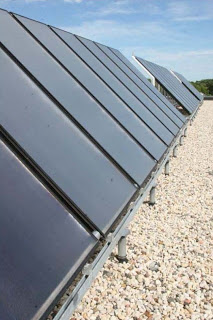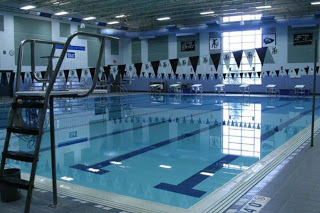by jboullion | Dec 31, 2009 | Uncategorized
Though written in 2007, an analysis by RENEW’s executive director Michael Vickerman may be even truer today an a few years ago, given the risk involved in “traditional” investments. The analysis shows that an investmnet in a solar hot water system generates a better rate of return than putting money in the bank:
I wrote a column which was highly critical of using payback analysis to figure out whether installing a solar hot water system on one’s house makes economic sense. In almost every example you can imagine, the payback period for today’s solar installations ranges between long and forever. For my system, which started operating in January 2006, payback will be achieved in a mere 19 years using today’s energy prices, though by the time 2025 rolls around, half of Florida might be under water and the rest of the country out of natural gas.
But there’s no reason to let payback length rule one’s ability to invest in sustainable energy for the home or business, especially if there are other approaches to valuing important economic decisions. One way to sidestep the gloomy verdicts of payback analysis is to do what most companies do when contemplating a long-term investment like solar energy — calculate the internal rate of return (IRR) on the invested capital. The definition of IRR is the annualized effective compounded return rate which can be earned on the invested capital, i.e. the yield on the investment.
By using this familiar capital budgeting method, I’m able to calculate an IRR of 6.1%for my solar water heater if natural gas prices rise a measly 3% per annum. That yield exceeds anything that a bank will offer you today. It will likely outperform the stock market this year, which is due for a substantial downward adjustment to reflect the slow-motion implosion of the housing market now underway. And, unless you live in a gold-rush community like Fort McMurray, Alberta, your house will do well just to hold onto its current valuation, let alone appreciate by six percent.
While all investments pose some degree of risk, the return on a solar energy system is about as safe and predictable as, well, the rising sun. Fortunately for the Earth and its varied inhabitants, the center of our solar system is situated well beyond the reach of humanity’s capacity to tamper with a good thing.
by jboullion | Dec 18, 2009 | Uncategorized
By Michael Vickerman, RENEW Wisconsin
As a result of educating themselves on the connection between energy use and atmospheric pollution, several school districts in Wisconsin are taking increasingly aggressive steps to conserve energy as well as produce a portion of what they use on-site. Some have embraced ground source heat pump systems (Fond du Lac High School), while others have installed solar hot water systems (Osceola Middle School) and solar electric systems (Paul Olson elementary school in Madison). Not to be outdone, Wausau East High School recently installed a 100 kilowatt (kW) Northwind turbine, which is now the largest wind generator attached to a school building in Wisconsin.
Yet if one measures success by substantial reductions in energy expenditures and emissions reductions, there is one school district in Wisconsin that stands head and shoulders above its peers: Fort Atkinson. Serving 2,700 school-age children in a community of 12,000, the Fort Atkinson School District operates six buildings: four elementary schools, one middle school and a high school. School officials have made no secret of their aspiration to make Fort Atkinson the most energy-efficient and self-sufficient K-12 district in the state.
Since 2005, Fort Atkinson has rigorously pursued a sustainable energy agenda that integrates, in a systematic and complementary fashion, continuous monitoring of consumption, aggressive building efficiency measures, and renewable energy capture. As articulated in its 2009 energy plan, the district’s principal goals for 2010 are nothing if not ambitious:
Pare energy costs by 20% from 2005 levels;
Lower carbon emissions by 25% from 2005 levels;
Obtain EnergyStar certification for all six schools; and
Install on-site renewable production at all six schools.
Virtually every renewable energy technology or efficiency measure available to a Wisconsin K-12 district has already been or is about to be deployed somewhere in Fort Atkinson. This lengthy list includes ground source heat pumps, solar hot water systems, lighting retrofits, tankless water heaters, retro-commissioning, occupancy sensors, window replacement, and roof insulation. On the district’s 2010 installation list are a 50 kW wind generator at the high school and a 20 kW solar electric system at Purdy elementary school.
The integrated approach pursued by Fort Atkinson leads to lower operating expenses, which in turn frees up capital for renewable technologies that have higher up-front costs but will deliver energy to the school buildings long after the initial investment is paid off. At the same time, converting sunlight and wind into useful energy sources enable building owners to reduce the variability of their utility costs. For a school district, that means not having to worry about the effect of a colder-than-normal winter on next year’s budget for textbooks.
The solar water heating systems serving the high school and the middle school neatly illustrate this benefit. The radiant energy striking the rooftop panels year-round is efficiently collected and taken inside to preheat the swimming pools in each building. Except during the winter months, the incoming solar energy is sufficient to maintain pool temperatures at 84°F. Even in January, however, the savings that a solar hot water system yields simply by preheating a pool to 70°F is substantial when multiplied over several decades.
The capital required to heat a swimming pool with solar energy is not trivial. For the 48-panel system atop the high school, the installed cost totaled $192,000, while the 32-panel installation serving the middle school came in at $115,000. Dennis Kuchenmeister, who manages the district’s buildings and grounds, estimates a 5% return on investment (ROI) for the high school’s system and an 11% ROI on the middle school’s system. According to Kuchenmeister, the hot water systems will supply about 60% of the heat going into the pools, displacing the equivalent of nearly 9,000 therms a year. The district expects to save $18,000 in avoided fuel costs per year.
Kuchenmeister’s economic estimates factor in incentives from Focus on Energy covering up to 35% of the total installed cost and matching incentives from We Energies, the local utility serving the school district. By taking full advantage of available incentive dollars, the school district was able to reduce the out-of-pocket portion of installation costs by more than 50%.
Because the annual harvest of solar energy striking a particular spot rarely fluctuates by more than 10%, a building owner can be reasonably confident of how much conventional energy an installation will displace. In contrast, the cost of heating a pool with natural gas can easily triple during a 12-month period even when usage remains constant. This in fact happened to Fort Atkinson in the 12 months preceding the installation of its two solar hot water systems in the fall of 2008.
Thus, the real value of Fort Atkinson’s solar hot water installations is in minimizing the district’s exposure to the price volatility associated with unregulated fossil fuels like natural gas. And while it’s true that natural gas prices are presently at five-year lows, they could easily bounce back to 2008 levels in a year or two, depending on events over which end-users have no control. However, by installing a renewable technology that preheats their swimming pools, Fort Atkinson has effectively insured itself against a repeat appearance of the fossil fuel rollercoaster ride that most school districts would just as soon forget.
There are two other reasons why school buildings are well-matched for solar energy installations. First, the buildings themselves are dedicated to a public function that is expected to last for several generations. In such settings it is easier to justify the additional up-fronts costs, especially if the installation also communicates a valuable lesson in sustainability to the entire community. Second, most schools, especially newer ones, have an abundance of flat, unshaded roof space that can support large arrays, irrespective of building orientation.
Real-time production data from both installations can be accessed online by visiting www.fatspaniel.net and searching for the live sites listed under We Energies. The district also uses Energy Watchdog, a web-based program provided by Focus on Energy to track energy usage. This program enables Fort Atkinson to document the energy and cost reductions from measures specified in its energy plan.
The middle school is also one of four schools in Fort Atkinson equipped with ground source heat pump systems that heat and cool the buildings year-round using the nearly constant temperatures in the ground. These systems heat buildings in the winter and cool them in the summer. Ground source heat pump systems are electrically powered; no heating fuel like natural gas or propane is needed to heat the four schools.
“We essentially cut the gas line to our schools,” said Kuchenmeister during a presentation on his district’s sustainable energy initiative last November in Milwaukee.
The operational costs of ground source heat pumps are substantially lower than the HVAC systems they replace. As a result of their renovation, the three elementary schools have seen their energy intensity drop by more than one-half, even though they now have air-conditioning in the classrooms. School officials estimate that all four ground source heat pump systems will save the district $90,000 annually in fuel costs.
As with solar hot water systems, Focus on Energy provides incentives for ground source heat pumps to schools, businesses and residences. The program awarded more than $96,000 towards the four systems installed in Fort Atkinson.
According to a Focus on Energy fact sheet, “a ground source heat pump system is arguably the most efficient technology for heating and cooling Wisconsin homes and businesses.” Given its embrace of that technology and others deployed in its buildings, Fort Atkinson has become, in terms of energy sustainability, arguably the most forward-thinking school district in the state.
RENEW Wisconsin (www.renewwisconsin.org) is an independent, nonprofit 501(c)(3) organization based in Madison that acts as a catalyst to advance a sustainable energy future through public policy and private sector initiatives. Michael Vickerman has been the organization’s executive director since 1991.
Solar Hot Water Systems – Fact Sheet
Fort Atkinson School District
Full Service Installers
Andy DeRocher
Mark O’Neal
Full Spectrum Solar
100 South Baldwin Street, Suite 101
Madison, WI 53703
Phone: 608.284.9495
info@fullspectrumsolar.com
www.fullspectrumsolar.com
Types of system installations:
Solar hot water, solar electric
Service Territory:
150 miles
At-A-Glance – High School SHW System
Collector space: 1,920 sq. ft (48 4’x10′ panels)
Panel manufacturer: Heliodyne Gobi
Tilt angle: 45 degrees
Annual fuel savings: 8,539 therms assuming 80% efficient gas boilers
Avoided CO2 emissions: 47 tons/year
Pool Size: 4,200 sq. ft.
Preheated water volume: 188,227 gallons
Pool operating temperature: 80°F
Incoming water temperature: 55°F
Installation cost: $192,000
Focus on Energy Incentive: $50,000
We Energies match: $50,000
System payback: 10 ¾ years
Installation date: Fall 2008
At-A-Glance – Middle School SHW System
Collector space: 1,280 sq. ft (32 4’x10′ panels)
Panel manufacturer: Heliodyne Gobi
Tilt angle: 45 degrees
Annual fuel savings: 8,763 therms assuming 60% efficient gas boiler
Avoided CO2 emissions: 49 tons/year
Pool Size: 2,635 sq. ft.
Preheated water volume: 96,921 gallons
Pool operating temperature: 84°F
Incoming water temperature: 55°F
Installation cost: $115,000
Focus on Energy Incentive: $40,400
We Energies match: $40,400
System payback: 4 years
Installation date: Fall 2008
by jboullion | Dec 10, 2009 | Uncategorized
From a news release issued by Focus on Energy:
MADISON, Wis. (Dec. 9, 2009) — Central Waters Brewing Company of Amherst, Wis., received a $25,000 financial incentive from Focus on Energy, Wisconsin’s statewide
resource for energy efficiency and renewable energy, for the installation of its solar hot-water system. The renewable energy system will dramatically lower the brewery’s consumption of natural gas, reducing its operating costs and shielding it from increases in energy prices.
With 1,000 square feet of collector area and a 2,500-gallon storage tank, the system is expected to meet more than 18 percent of the brewery’s annual hot-water needs, saving at least $150,000 over its lifetime.
Every day, Central Waters’ brewing process uses about 1,500 gallons of water heated to 165 degrees Fahrenheit. Before the solar hot-water system, this water was heated entirely using natural gas. Now, the water is pre-heated by the sun to a temperature of 130 degrees to 140 degrees. A natural-gas boiler heats the water the rest of the way, dramatically reducing the amount of natural gas the brewery consumes. Central Waters also uses the preheated water to clean tanks and kegs — an energy-intensive job that requires a water temperature of 180 degrees.
“Focus has been a great partner who’s helped us along as we’ve installed the solar hotwater system,” said Paul Graham, president of Central Waters Brewing Company. “Focus paid nearly 25 percent of our costs for the equipment and installation. Plus, there’s a 30 percent federal tax credit for businesses and individuals.”
by jboullion | Dec 7, 2009 | Uncategorized


Governor Jim Doyle signals a crane operator to lift the first pallet of solar panels (left) for installation on the West Wing of the State Capitol. Madison Gas and Electric (MGE) President Gary (middle) and Chris Collins (right), a representative of the installer H&H Solar, joined in the liftoff.
The 48 solar panels in the final installation will cover 9,600 square feet on the Capitol roof and produce about 11,700 kilowatt hours of electricity a year, slightly more than a typical Wisconsin home would use annually.The system will be owned and maintained by MGE, which is fully funding the $78,000 project.

by jboullion | Dec 7, 2009 | Uncategorized


The solar water heating systems serve Fort Atkinson high school and the middle school. The radiant energy striking the rooftop panels year-round is efficiently collected and taken inside to preheat the swimming pools inside each structure. Except during the winter months, the incoming solar energy is sufficient to maintain pool temperatures at 84°F. Even in January, however, the savings that a solar hot water system yields simply by preheating a pool to 70°F is substantial when multiplied over several decades.
From a story by Michael Vickerman, RENEW’s executive director:
As a result of educating themselves on the connection between energy use and atmospheric pollution, several school districts in Wisconsin are taking increasingly aggressive steps to conserve energy as well as produce a portion of what they use on-site. Some have embraced ground source heat pump systems (Fond du Lac High School), while others have installed solar hot water systems (Osceola Middle School) and solar electric systems (Paul Olson elementary school in Madison). Not to be outdone, Wausau East High School recently installed a 100 kW Northwind turbine, which is now the largest wind generator attached to a school building in Wisconsin.
Yet if one measures success by substantial reductions in energy expenditures and emissions reductions, there is one school district in Wisconsin that stands head and shoulders above its peers: Fort Atkinson. Serving 2,700 school-age children in a community of 12,000, the Fort Atkinson School District operates six buildings: four elementary schools, one middle school and a high school. School officials have made no secret of their aspiration to make Fort Atkinson the most energy-efficient and self-sufficient K-12 district in the state.
Since 2005, Fort Atkinson has rigorously pursued a sustainable energy agenda that integrates, in a systematic and complementary fashion, continuous monitoring of consumption, aggressive building efficiency measures, and renewable energy capture. As articulated in its 2009 energy plan, the district, the district’s principal goals for 2010 are nothing if not ambitious:
+ Pare energy costs by 20% from 2005 levels;
+ Lower carbon emissions by 25% from 2005 levels;
+ Obtain EnergyStar certification for all six schools; and
+ Install on-site renewable production at all six schools.




